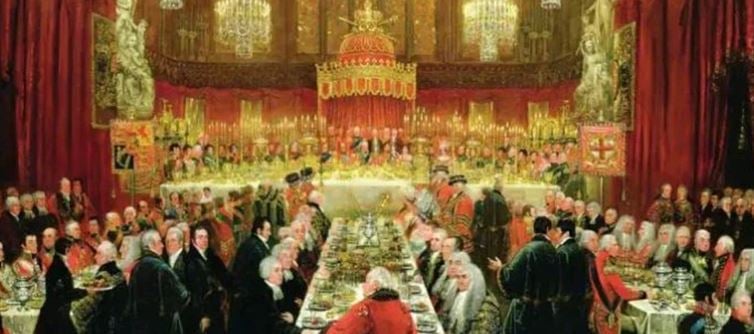
🏛️WHEN A king FED THE WORLD
Long before Michelin stars, celebrity chefs, and billionaire weddings, one man threw a feast so massive that the world still hasn’t topped it in nearly 3,000 years. His name was Ashurnasirpal II, the warrior-king of the Assyrian Empire. The year was around 879 BCE.
The place — Kalhu (modern-day Nimrud, Iraq) — is a freshly rebuilt capital city glimmering with cedarwood ceilings, bronze doors, and gold-lined halls.
To celebrate his new palace and his empire’s might, Ashurnasirpal didn’t just host a dinner.
He fed an empire — for 10 straight days, with nearly 70,000 guests, thousands of animals, and oceans of beer and wine.
This wasn’t a feast.
It was a political earthquake disguised as a party.
👑 THE HOST: ASHURNASIRPAL II — THE king WHO ATE EMPIRES FOR BREAKFAST
Ashurnasirpal II wasn’t your average ruler.
He was a conqueror, an empire-builder, and a man obsessed with legacy. His reign (883–859 BCE) marked the height of Assyrian power, stretching from Mesopotamia to the Mediterranean.
But military might wasn’t enough. He wanted eternal remembrance.
So when he rebuilt Kalhu as his new capital — complete with a “Palace of Delight” — he decided to throw a banquet that would immortalize his name in stone.
And that’s exactly what he did.
The details of the event survive on the Banquet Stele — a stone tablet describing the world’s first recorded mega-fest, etched forever in cuneiform.
It’s not just a record of food.
It’s the oldest known menu in human history.
🍖 10 DAYS. 69,574 GUESTS. A FEAST FIT FOR THE GODS.
For ten days, the city of Kalhu turned into a carnival of abundance.
69,574 guests flooded in — nobles, soldiers, officials, envoys, artisans, commoners, and even conquered peoples invited from rebellious regions.
This was diplomacy by dinner plate.
Each guest was fed, honored, gifted, and anointed in oil before being sent home in peace.
The feast wasn’t just about indulgence — it was a performance of power.
To feed 70,000 people in the 9th century BCE was the equivalent of hosting the entire population of a modern capital without electricity, refrigeration, or logistics tech — just sheer human coordination and imperial muscle.
🍗 THE MENU THAT FED A KINGDOM
What did they eat? Everything that walked, swam, or flew.
According to the Banquet Stele, here’s a glimpse of what was served:
1,000 bulls
1,000 calves
10,000 sheep
15,000 lambs
500 deer and 500 gazelles
1,000 ducks, 500 swans, 5,000 curlews, 1,000 mesuku birds, 1,000 caribu birds
10,000 pigeons, 10,000 sukanunu pigeons, and another 10,000 small birds
10,000 fish, 10,000 eggs, and 14,000 additional sheep as sacrificial offerings
And to wash it all down:
10,000 jars of beer
10,000 containers of wine
Add to that fruits, vegetables, breads, cheeses, herbs, honey, and preserved delicacies — and you have a menu that reads like an ancient god’s shopping list.
This was not a feast of survival — it was a feast of supremacy.
⚔️ THE STRATEGY BEHIND THE FEAST
Why go through such extravagance? Because Ashurnasirpal II understood the psychology of spectacle.
In a time when empires rose and fell by fear, he used feasting as a weapon — a political flex wrapped in hospitality.
By inviting nobles, generals, allies, and even subjects from newly conquered lands, he turned potential enemies into admirers.
Every dish was propaganda.
Every toast is a declaration of loyalty.
Feeding 70,000 people for ten days sent a single, thunderous message across the ancient world:
“I am the king who can feed nations.”
🏰 THE PALACE OF DELIGHT: A CITY REBORN
The banquet marked the opening of Kalhu, his new capital.
It was no ordinary city.
Kalhu was designed as a symbol of eternal kingship — sprawling courtyards, towering ziggurats, and palace walls covered in reliefs depicting his conquests.
Cedarwood ceilings perfumed the halls, bronze gates shimmered under the Mesopotamian sun, and gardens lined with canals stretched toward the horizon.
The banquet wasn’t just a party; it was a public dedication ceremony — part religious ritual, part imperial propaganda, part celebration of urban rebirth.
🍷 THE AFTERMATH: WHEN THE party BECAME LEGEND
When the feast ended, the guests were sent away “in peace and happiness.”
But the world had already taken notice.
Ashurnasirpal II’s banquet became the first event in recorded history where food, politics, and power merged into a single grand narrative.
It proved that spectacle could sustain empire — a lesson rulers have repeated for millennia.
From Roman triumphs to Versailles galas, from Mughal darbars to modern state dinners — the dna of all grand feasts traces back to this one 10-day orgy of abundance.
🔥 CONCLUSION: WHEN POWER TASTED LIKE GLORY
history remembers wars and monuments, but it also remembers the meals that built empires.
Ashurnasirpal II didn’t just rule — he fed the idea of empire itself.
In ten days, he carved his power into legend, served on plates of bronze and gold, washed down with 10,000 jars of beer.
Three thousand years later, no billionaire wedding, royal coronation, or political rally has outdone his scale.
He didn’t just throw the world’s biggest banquet.
He invented the art of ruling through awe —
and for ten days, the world truly ate out of his hand.




 click and follow Indiaherald WhatsApp channel
click and follow Indiaherald WhatsApp channel